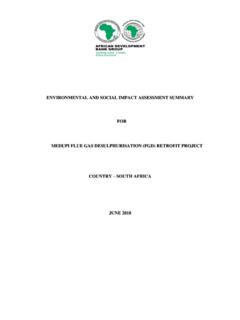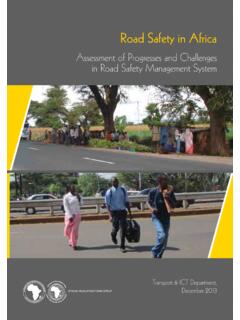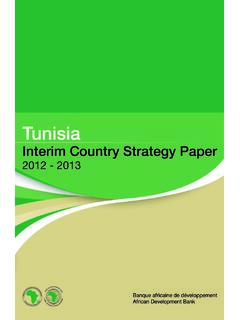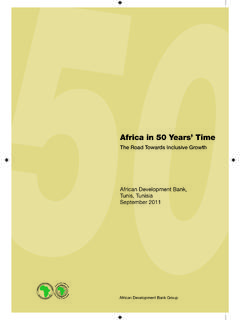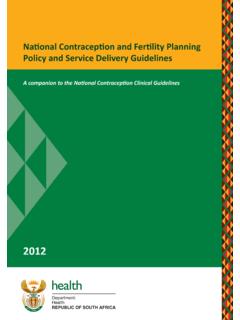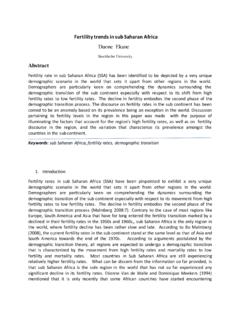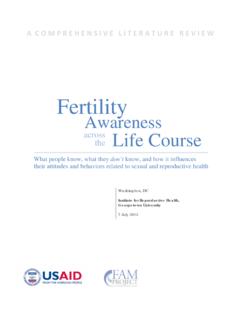Transcription of Briefing Note 4: AFRICA S DEMOGRAPHIC TRENDS
1 AFRICAN DEVELOPMENT BANK GROUP Briefing Notes for AfDB s Long-Term Strategy Briefing Note 4: AFRICA S DEMOGRAPHIC TRENDS1 1 The Briefing Note was prepared by Maurice Mubila, Chief Statistician, 2 Date: 7 March 2012 1 AFRICA S DEMOGRAPHIC TRENDS I. INTRODUCTION One of, if not the overriding objective of development is to improve the quality of life for all the people. Populations are therefore at the core of development. Understanding DEMOGRAPHIC TRENDS provides policy-makers with the tools to design interventions that lead to development by for example targeting social sectors (health, education and labor) and providing tailored infrastructure services.
2 Knowledge on the population is crucial for planning resource allocation and designing appropriate policies. AFRICA s current and projected DEMOGRAPHIC TRENDS growing population, urbanization, and the ratio of working age to non-working age and aging populations -- require in turn appropriate responses to the anticipated pressures on food, energy, and water resources. Policy formulation must also consider the implication for greater mobility, demand for jobs, social safety nets the uncertain effects of climate change.
3 Anticipated DEMOGRAPHIC TRENDS in population growth and age structures are important drivers of economic growth. Over the coming decades, these TRENDS are projected to lead to high levels of economic growth in some African countries, if the right policies are put in place. DEMOGRAPHIC TRENDS are thus likely to provide an opportunity to reduce poverty and yield a DEMOGRAPHIC dividend that will lead to economic success as it did in the Asian emerging markets: as much as one-third of East Asia s economic miracle is attributed to DEMOGRAPHIC change (Bloom and Canning, 2011).
4 On the other hand, in countries with sparse resources and inadequate policies, population growth could lead to economic decline and social misery. II. AFRICA S DEMOGRAPHIC TRENDS fertility Rates. In projections to 2030, the African population is expected to peak at billion from billion in 2010 (Graph 1), which would represent 19% of the world s population. Asia and Latin America will account for 58% and 8%, of world population, respectively. These projections rely upon assumptions about vital fertility and mortality rates.
5 The fertility rate is assumed to decline at a varying pace by country, and follow a trajectory similar to the one in other major global areas. GRAPH 1 : AFRICA TOTAL POPULATION (BILLIONS) Source: AfDB based on UN Population Division data. 0,000,501,001,502,0019902010201220222030 2 Lower fertility rates will lower AFRICA s overall annual population growth rate to 2% by 2030, compared to Asia at , Latin America and the Caribbean at , Eastern Europe, and the world as a whole at The dynamic will be similar in all African sub-regions, with the exception of the North AFRICA region, where population growth will decline at about a year by 2030 (Graph 2).
6 GRAPH 2: AFRICA POPULATION GROWTH RATES BY SUB-REGIONS Source: AfDB based on UN Population Division data. Although, fertility TRENDS in the developing world suggest that a decline often continues without significant interruption until the replacement level of around two births per woman is reached, recent evidence contradicts it. fertility declines in developing countries, including in AFRICA , have slowed or stalled in a number of countries in transition. The rate of fertility decline slowed down ( stalled) significantly in sub-Saharan AFRICA in the 1990s and early 2000s.
7 In the 1990s, declining GDP per capita contributed to slowing fertility rate declines as did the AIDS epidemic, with raised infant and child mortality rates. Poorly performing economies returned populations to subsistence and stalled fertility declines in many sub-Saharan countries (Bongaarts, 2008). In addition, domestic economic crisis and lower donor budgets assigned to family planning programs in a number of countries could also be factors inhibiting fertility decline. The slow pace of fertility decline around 2000 in sub-Saharan AFRICA has significant implications for future DEMOGRAPHIC TRENDS : even minor variations in fertility TRENDS have large effects on a population s future size and age structure (Casterline, 2001).
8 It implies a growing population in the coming decades, which may lead to some adverse effects on the prospects for social and economic development, food security, and the sustainability of natural resources, unless appropriate policies are designed. On the other hand, lower fertility can yield a DEMOGRAPHIC dividend, with the proportion of the working age population increasing relative to the proportion of children 00,511,522,533,519902010201220222030 AfricaCentral AfricaEast AfricaNorth AfricaSouthern AfricaWest Africa3 and the elderly.
9 This DEMOGRAPHIC dividend could significantly contribute to developing human resources and employment creation with the appropriate policies. For example, as the birth rate in the Republic of Korea fell in the mid-1960s, elementary school enrolments declined and funds previously allocated to elementary education were used to improve the quality of higher levels of education (Ross, 2004). Mortality Rates are generally poised to improve over the coming decades as communicable diseases in AFRICA continue to be addressed, although malaria remains endemic in most African countries and continues to represent a major cause of morbidity and mortality.
10 Much progress is nonetheless expected in child and infant mortality rates: child mortality is projected to decline from 116 per 1000 live deaths in 2010 to 75 per 1000 live deaths in 2030 (Graph 3) thanks to better incomes, access to improved water supply and sanitation, and better health facilities. GRAPH 3: AFRICA UNDER-FIVE MORTALITY RATES PER 1,000 LIVE BIRTHS BY REGION Source: AfDB based on UN Population Division data. The North AFRICA and East AFRICA sub-regions are projected to benefit more from reduced child mortality than other regions.
